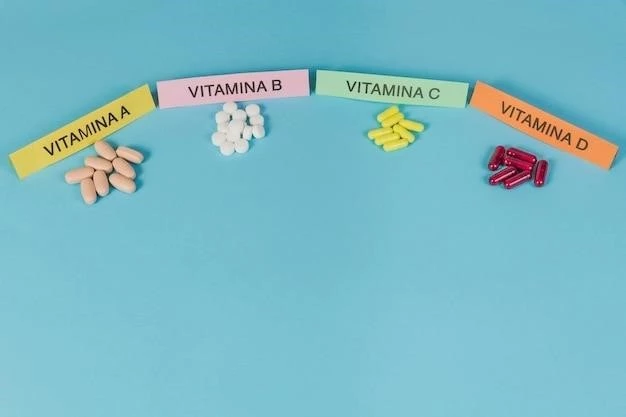Hypervitaminosis E
Disease⁚ Hypervitaminosis E
Hypervitaminosis E is a condition caused by excessive intake of vitamin E, leading to toxicity. This article will cover symptoms, diagnosis, treatment, prevention, antioxidants’ role, health implications, and supplements related to this condition.
Introduction to Hypervitaminosis E
Vitamin E is a group of fat-soluble compounds known for their antioxidant properties. While vitamin E is essential for various bodily functions, excessive intake can lead to hypervitaminosis E, causing toxicity. The main forms of vitamin E include alpha-tocopherol, beta-tocopherol, gamma-tocopherol, and delta-tocopherol.
Hypervitaminosis E typically occurs through overconsumption of vitamin E supplements beyond the recommended daily intake or prolonged use of high-dose supplements. Although rare, it can also result from excessive dietary intake of vitamin E-rich foods like nuts, seeds, and vegetable oils. The body stores excess vitamin E in fat tissues, leading to a slow buildup and manifestation of symptoms over time.
Understanding the signs, symptoms, diagnosis, treatment, prevention, and implications of hypervitaminosis E is crucial for healthcare professionals and individuals to recognize and manage this condition effectively. Due to the potential health risks associated with vitamin E toxicity, it is essential to maintain a balanced approach to vitamin E consumption and supplement usage.
Symptoms of Hypervitaminosis E
Recognizing the symptoms of hypervitaminosis E is fundamental in diagnosing and treating this condition promptly. Common signs of vitamin E toxicity can vary depending on the severity and duration of excessive intake. Early symptoms may include gastrointestinal distress such as nausea, diarrhea, or stomach cramps.
As hypervitaminosis E progresses, individuals might experience more severe symptoms such as fatigue, weakness, blurred vision, and headaches. In some cases, prolonged vitamin E overdose can lead to excessive bleeding tendencies due to its impact on blood clotting mechanisms. Skin reactions like rash, itching, or even skin inflammation may also occur.
Neurological symptoms like dizziness, impaired reflexes, and muscle weakness can manifest in severe cases of hypervitaminosis E. It is essential to note that symptoms of vitamin E toxicity can mimic other health conditions, making accurate diagnosis crucial for appropriate management.
Individuals with existing health conditions, such as liver disease or clotting disorders, may be more susceptible to the adverse effects of vitamin E overdose. Monitoring for symptoms and promptly seeking medical advice if experiencing any unusual health issues related to excessive vitamin E intake is paramount.
Diagnosis of Hypervitaminosis E

Diagnosing hypervitaminosis E involves a comprehensive assessment of an individual’s medical history, symptoms, and potential exposure to excessive amounts of vitamin E through diet or supplements. Healthcare providers may conduct a physical examination to evaluate signs of vitamin E toxicity, such as skin changes, neurological abnormalities, or blood clotting irregularities.
Laboratory tests can assist in confirming a diagnosis of hypervitaminosis E. Blood tests measuring levels of vitamin E in the bloodstream can indicate elevated concentrations beyond the normal range, indicating excessive intake. Additionally, liver function tests may be performed to assess any potential impact on liver health due to vitamin E overload.
Diagnostic imaging techniques, such as ultrasound or MRI scans, may be utilized to evaluate liver health and detect any abnormalities associated with hypervitaminosis E. In cases where neurological symptoms are present, neurological assessments and imaging studies may be necessary to assess the extent of nerve damage or dysfunction.
Collaboration between healthcare professionals, including primary care physicians, specialists, and nutritionists, is essential in accurately diagnosing hypervitaminosis E and formulating a tailored treatment plan. Timely and precise diagnosis can prevent further complications and guide appropriate management strategies for individuals affected by vitamin E toxicity.
Treatment for Hypervitaminosis E
The treatment approach for hypervitaminosis E primarily focuses on discontinuing the intake of vitamin E supplements and reducing consumption of vitamin E-rich foods to prevent further toxicity. Healthcare providers may recommend a gradual reduction in vitamin E intake to avoid abrupt changes that could impact the body’s equilibrium.
In cases where symptoms of hypervitaminosis E are severe, medical supervision may be necessary to monitor and manage potential complications. Supportive care to address specific symptoms, such as gastrointestinal issues, skin reactions, or neurological manifestations, may be provided to alleviate discomfort and promote recovery.
For individuals experiencing bleeding tendencies due to vitamin E overdose, interventions to address coagulation abnormalities, such as administering vitamin K or clotting factors, may be necessary to restore normal blood clotting function. Monitoring blood clotting parameters through lab tests is crucial to assess the effectiveness of interventions.
Preventive measures to safeguard against future episodes of hypervitaminosis E may involve dietary counseling to ensure a balanced intake of essential nutrients, including vitamins and minerals. Healthcare professionals can guide individuals on appropriate vitamin E dosages and the importance of adhering to recommended dietary guidelines to avoid excessive intake.
Regular follow-up visits with healthcare providers allow for ongoing evaluation of symptoms, monitoring of vitamin E levels in the body, and adjustment of treatment strategies as needed. By collaborating with a multidisciplinary healthcare team, individuals can receive comprehensive care tailored to effectively address hypervitaminosis E and promote optimal health outcomes.
Prevention of Hypervitaminosis E
Preventing hypervitaminosis E involves adopting mindful practices regarding the intake of vitamin E from dietary sources and supplements. Individuals should be aware of the recommended daily allowance for vitamin E, which varies based on age, sex, and overall health status.
Choosing a balanced and varied diet that includes a mix of nutrient-dense foods can help prevent excessive vitamin E intake. Incorporating a variety of fruits, vegetables, whole grains, lean proteins, and healthy fats into daily meals can contribute to a well-rounded nutritional profile.
When considering vitamin E supplementation, it is essential to consult with a healthcare provider or a registered dietitian to determine if additional supplementation is necessary. Selecting high-quality supplements from reputable brands and following recommended dosages can reduce the risk of vitamin E overdose.
Reading product labels and understanding the concentration of vitamin E in supplements can aid in making informed decisions about supplementation. Avoiding self-prescription or consuming multiple vitamin E supplements concurrently is crucial to prevent inadvertent overdosing and toxicity.
Regular health check-ups and discussions with healthcare professionals can provide valuable insights into individual nutritional needs and potential risks associated with excessive vitamin E consumption. By staying informed and proactive about dietary choices and supplement usage, individuals can take proactive steps to prevent hypervitaminosis E and maintain optimal health.
Antioxidants and Hypervitaminosis E
Antioxidants play a crucial role in maintaining cellular health by neutralizing harmful free radicals that contribute to oxidative stress. Vitamin E, a potent antioxidant, is known for its ability to protect cells from damage caused by free radicals and support overall well-being.
However, excessive intake of vitamin E can lead to hypervitaminosis E, a condition characterized by toxicity and adverse health effects. While moderate consumption of antioxidants like vitamin E is beneficial, an imbalance resulting from over-supplementation can disrupt the body’s antioxidant balance and lead to detrimental outcomes.
It is essential to consume antioxidants in appropriate amounts within the recommended daily intake levels to harness their protective benefits without risking toxicity. A diverse diet rich in fruits, vegetables, nuts, and seeds can provide a natural source of antioxidants, including vitamin E, to support optimal health.
For individuals considering antioxidant supplementation, it is advisable to seek guidance from healthcare professionals to determine the most suitable approach based on individual needs and health status. Understanding the interactions between antioxidants and their impact on overall health can help prevent imbalances that may contribute to conditions like hypervitaminosis E.
By maintaining a well-rounded diet, engaging in regular physical activity, and making informed choices about antioxidant supplementation, individuals can harness the benefits of antioxidants like vitamin E while mitigating the risks associated with excessive intake. Striking a balance in antioxidant consumption is key to promoting cellular health and overall wellness.
Health Implications of Hypervitaminosis E
Hypervitaminosis E can have significant health implications, ranging from mild discomfort to severe complications, depending on the extent of vitamin E toxicity. Prolonged excessive intake of vitamin E can disrupt normal physiological functions and lead to various adverse effects throughout the body.
One of the primary health implications of hypervitaminosis E is its impact on blood clotting mechanisms. Excessive levels of vitamin E can interfere with the body’s ability to form blood clots, increasing the risk of uncontrolled bleeding and hemorrhagic disorders.
Neurological complications may also arise in individuals with hypervitaminosis E, manifesting as symptoms like dizziness, impaired coordination, and muscle weakness. Vitamin E toxicity can affect nerve function and contribute to neurological dysfunction if left untreated.
Skin-related issues, such as rash, itching, or dermatitis, are common manifestations of vitamin E overdose. These dermatological symptoms can cause discomfort and skin irritation, further underscoring the importance of monitoring vitamin E levels to prevent skin-related health implications.
Individuals with liver conditions may be particularly vulnerable to the health implications of hypervitaminosis E, as excess vitamin E can strain liver function and exacerbate existing liver disorders. Monitoring liver health and vitamin E levels is crucial in managing the impact on liver function.
Understanding the potential health implications of hypervitaminosis E underscores the importance of balanced vitamin E intake and vigilant monitoring of dietary sources and supplement usage. By recognizing the signs of vitamin E toxicity and seeking timely medical intervention, individuals can mitigate the health risks associated with excessive vitamin E consumption and promote overall well-being.
Supplements and Hypervitaminosis E
When it comes to supplements and hypervitaminosis E, caution and informed decision-making are essential to prevent vitamin E toxicity. Vitamin E supplements are widely available and often taken for their antioxidant properties and potential health benefits.
It is crucial for individuals to be aware of the recommended daily intake of vitamin E and avoid exceeding the established guidelines to reduce the risk of hypervitaminosis E. Excessive supplementation with vitamin E can lead to an imbalance in the body’s antioxidant levels and result in adverse effects.
Before initiating any new supplement regimen, consulting with a healthcare provider or a registered dietitian is recommended to assess individual nutritional needs and determine the appropriateness of vitamin E supplementation. Healthcare professionals can provide guidance on selecting high-quality supplements and ensuring safe dosages.
Monitoring vitamin E levels through regular blood tests can help individuals track their supplementation effects and detect early signs of vitamin E overdose. Adjusting supplement dosages in accordance with healthcare provider recommendations is crucial in preventing hypervitaminosis E.
Individuals should carefully read product labels, including the concentration of vitamin E per serving, and adhere to recommended dosages specified by the manufacturer. Combining multiple vitamin E supplements or using high-dose formulations without medical supervision can increase the risk of toxicity.
By maintaining open communication with healthcare providers, practicing diligence in supplement selection and dosage management, and prioritizing a balanced approach to nutrition, individuals can incorporate supplements safely into their routine while minimizing the likelihood of hypervitaminosis E and its associated risks.
